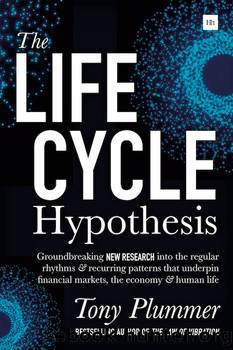The Life Cycle Hypothesis: Groundbreaking New Research Into the Regular Rhythms and Recurring Patterns That Underpin Financial Markets, the Economy and Human Life by Tony Plummer

Author:Tony Plummer [Plummer, Tony]
Language: eng
Format: epub
Tags: Business & Economics, economics, Theory, Investments & Securities, General
ISBN: 9780857196330
Google: UvhNDwAAQBAJ
Publisher: Harriman House
Published: 2018-11-15T00:08:50.337523+00:00
Figure 9-5: The 1942â1978 era
1942â78: A brief history
In terms of Figure 9-5, the Threshold Cycle covered the period when the US was involved in WWII. America entered the war after the Japanese attack on Pearl Harbour in December 1941, and finally ended the war with the dropping of atom bombs on Japan in August 1945. The imminent end of the cycle was undoubtedly marked by the Japanese surrender. The actual low of the cycle was then registered by industrial production in February 1946.
The Transition Cycle, which started in 1946, was subject to significant oscillations. There was an initial three-phase surge into a peak in 1950. However, the Korean War started in June 1950, and, as a result, the next significant move was an energy gap. It was this energy gap that ensured that the collective readjustment in the subsequent Transformation Cycle included an ongoing confrontation with Communism. The war in Korea ended in 1953; the transition phase of evolution ended in 1956.
The Transformation Cycle started in 1956. This cycle is particularly important. It includes the halfway point of the whole life cycle, it involves a period of evolutionary learning, and it incorporates new attitudes and ideas about the economy. This would have been the period when official policy included resistance to Communism, when government became more proactive in managing economic expectations, and when the consumer revolution got underway. Eventually, expectations ran too far ahead of reality. There was therefore a recession in 1966â67. However, reflecting the intrinsic strength of the economy during this period, most analysts see the recession as being more of a contraction in growth rather than a reflection of economic weakness. The transformation phase ended in 1967.
The Termination Cycle started in 1967. By this stage, the Cold War with the Soviet bloc was in full swing, and the US had become involved in a war in Vietnam. As the period progressed, the authorities became increasingly willing to finance their military needs by printing money. The US economy was therefore becoming vulnerable to shocks. There was a deep recession between 1969 and 1970, and the authorities responded with a Keynesian stimulus. This stimulus was initially successful, but it also unleashed the forces of inflation onto the economy. Between 1973 and 1975, industrial production encountered an energy gap. This gap started the ending process for the whole cycle. The cycle ended in 1978.
The 1978â2012/13 era
Figure 9-6 shows the second socio-economic era to have evolved in the period after WWII. The heavy line shows the 12-month percentage change in industrial production; the dashed line shows the momentum of the life cycle; and the diagram is divided in such a way as to show the underlying cyclical oscillations. Figure 9-6 accordingly starts with a Threshold Cycle (1978â80), and then proceeds through three oscillations of equal duration: the Transition Cycle (1980â91); the Transformation Cycle (1991â2001); and the Termination Cycle (2001â2012/13). The whole pattern takes 34â35 years to complete: the Threshold Cycle takes just two years (and the schematic has been adjusted to take account of this); and each of the subsequent sub-cycles takes about 11 years.
Download
This site does not store any files on its server. We only index and link to content provided by other sites. Please contact the content providers to delete copyright contents if any and email us, we'll remove relevant links or contents immediately.
Zero to IPO: Over $1 Trillion of Actionable Advice from the World's Most Successful Entrepreneurs by Frederic Kerrest(4069)
Machine Learning at Scale with H2O by Gregory Keys | David Whiting(3648)
Harry Potter and the Goblet Of Fire by J.K. Rowling(3612)
Never by Ken Follett(3537)
Ogilvy on Advertising by David Ogilvy(3345)
Shadow of Night by Deborah Harkness(3178)
The Man Who Died Twice by Richard Osman(2812)
Book of Life by Deborah Harkness(2723)
My Brilliant Friend by Elena Ferrante(2705)
How Proust Can Change Your Life by Alain De Botton(2617)
0041152001443424520 .pdf by Unknown(2603)
Will by Will Smith(2584)
The Tipping Point by Malcolm Gladwell(2563)
How to Pay Zero Taxes, 2018 by Jeff A. Schnepper(2503)
Purple Hibiscus by Chimamanda Ngozi Adichie(2498)
Hooked: A Dark, Contemporary Romance (Never After Series) by Emily McIntire(2426)
Rationality by Steven Pinker(2153)
Borders by unknow(2119)
Daughter of Smoke and Bone by Laini Taylor(2083)
